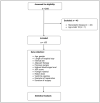Surgical Site Infections in Glioblastoma Patients-A Retrospective Analysis
- PMID: 37511730
- PMCID: PMC10381691
- DOI: 10.3390/jpm13071117
Surgical Site Infections in Glioblastoma Patients-A Retrospective Analysis
Abstract
Surgical site infections (SSIs) after craniotomy lead to additional morbidity and mortality for patients, which are related to higher costs for the healthcare system. Furthermore, SSIs are associated with a longer hospital stay for the patient, which is particularly detrimental in glioblastoma patients due to their limited life expectancy. Risk factors for SSIs have already been described for craniotomies in general. However, there is limited data available for glioblastoma patients. As postoperative radiation influences wound healing, very early radiation is suspected to be a risk factor for SSI. Nevertheless, there are no data on the optimal timing of radiotherapy. To define risk factors for these patients, we analyzed our collective. We performed a retrospective analysis of all operations with histological evidence of a glioblastoma between 2012 and 2021. Open biopsy and tumor removal (gross total resection, subtotal resection) were included. Stereotactic biopsies were excluded. Demographic data such as age and gender, as well as duration of surgery, diameter of the trepanation, postoperative radiation with interval, postoperative chemotherapy, highest blood glucose level, previous surgery, ASA score, foreign material introduced, subgaleal suction drainage, ventricle opening and length of hospital stay, were recorded. The need for surgical revision due to infection was registered as an SSI. A total of 177 patients were included, of which 14 patients (7.9%) suffered an SSI. These occurred after a median of 45 days. The group with SSIs tended to include more men (57.1%, p = 0.163) and more pre-operated patients (50%, p = 0.125). In addition, foreign material and subgaleal suction drains had been implanted more frequently and the ventricles had been opened more frequently, without reaching statistical significance. Surprisingly, significantly more patients without SSIs had been irradiated (80.3%, p = 0.03). The results enable a better risk assessment of SSIs in glioblastoma patients. Patients with previous surgery, introduced foreign material, subgaleal suction drain and opening of the ventricle may have a slightly higher for SSIs. However, because none of these factors were significant, we should not call them risk factors. A less radical approach to surgery potentially involving these factors is not justified. The postulated negative role of irradiation was not confirmed, hence a rapid chemoradiation should be induced to achieve the best possible oncologic outcome.
Keywords: glioblastoma; influencing factor; irradiation; radicality; retrospective analysis; surgical site infection.
Conflict of interest statement
The authors declare no conflict of interest.
Figures



References
-
- Wirsching H.-G., Galanis E., Weller M. Glioblastoma. [(accessed on 1 July 2023)];Handb. Clin. Neurol. 2016 134:381–397. Available online: https://pubmed.ncbi.nlm.nih.gov/26948367/ - PubMed
-
- Stupp R., Taillibert S., Kanner A., Read W., Steinberg D., Lhermitte B., Toms S., Idbaih A., Ahluwalia M.S., Fink K., et al. Effect of Tumor-Treating Fields Plus Maintenance Temozolomide vs Maintenance Temozolomide Alone on Survival in Patients With Glioblastoma: A Randomized Clinical Trial. JAMA. 2017;318:2306–2316. doi: 10.1001/jama.2017.18718. - DOI - PMC - PubMed
LinkOut - more resources
Full Text Sources
Research Materials
Miscellaneous

